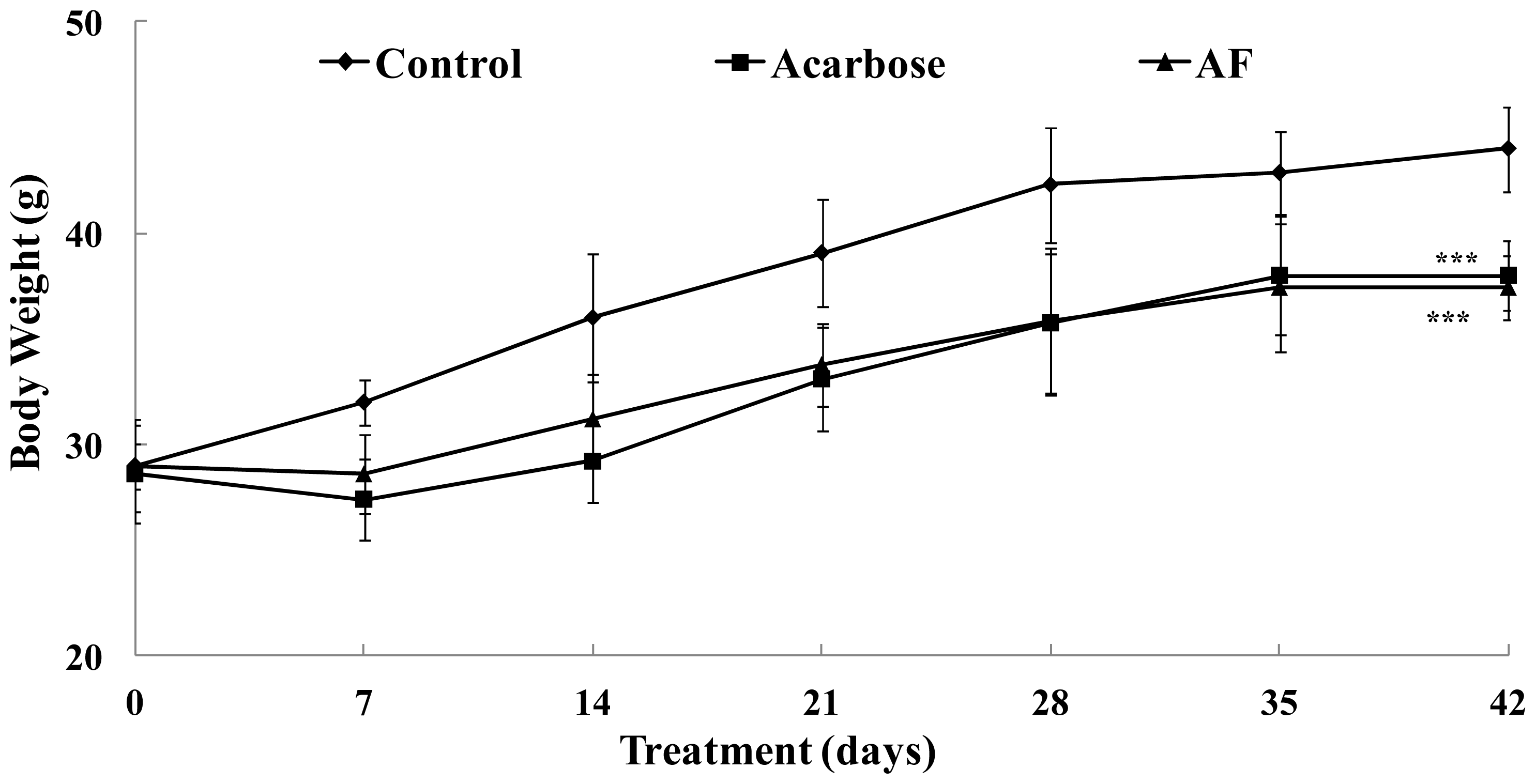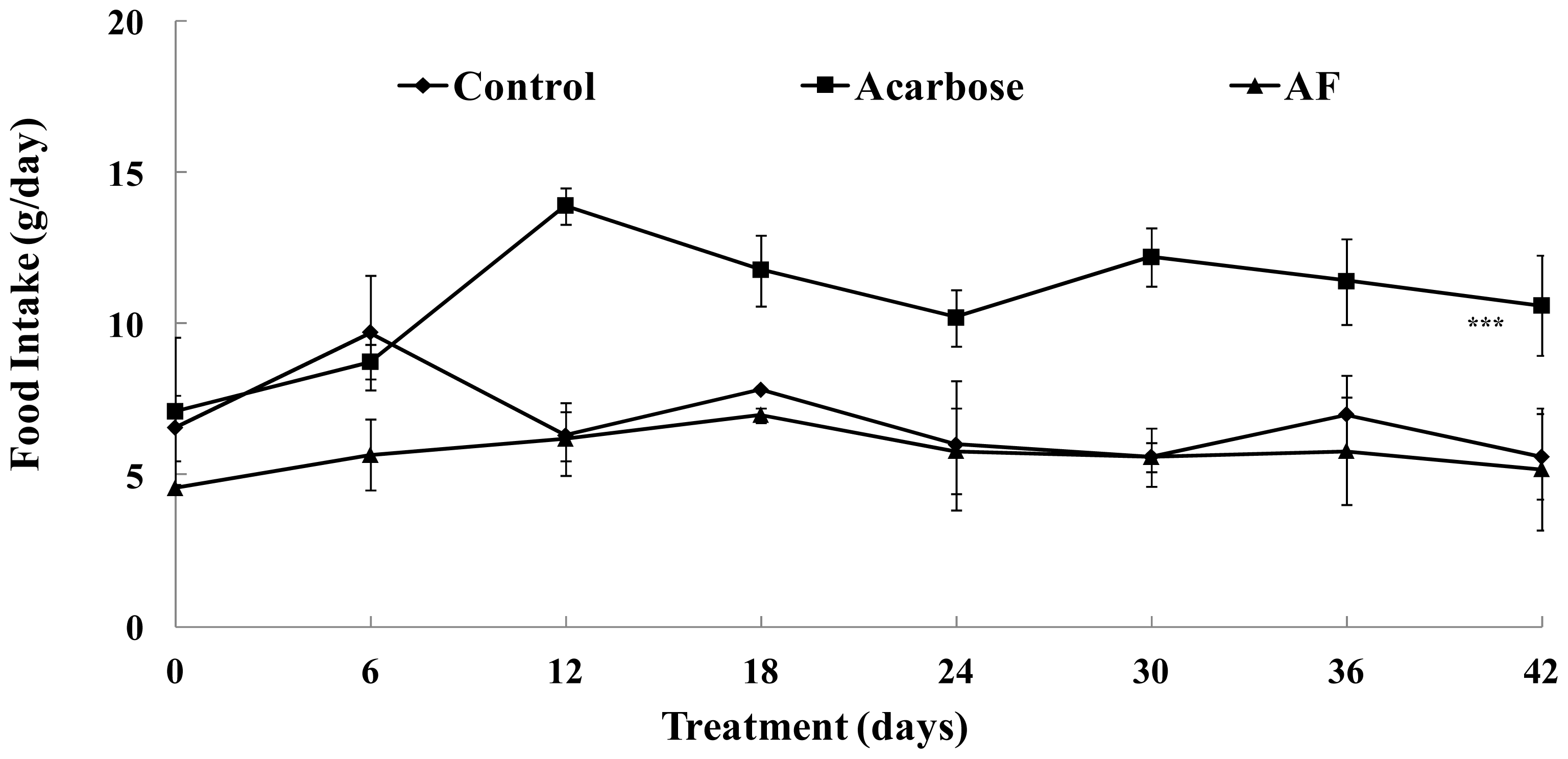Effect of Long-Term Dietary Arginyl-Fructose (AF) on Hyperglycemia and HbA1c in Diabetic db/db Mice
Abstract
:1. Introduction
2. Results and Discussion
db/db Mice Trial
3. Experimental Section
3.1. Materials
3.2. Animal and Study Design
3.3. Blood Analysis
3.4. Statistical Analysis
4. Conclusions
Acknowledgments
Conflicts of Interest
- Author ContributionsProfessor Kwon designed the study and directed its implementation, including the study’s analytic strategy. Professor Chung helped conduct the literature review and prepare the Methods and the Discussion sections of the text.
References
- Wild, S.; Roglic, G.; Green, A.; Sicree, R.; King, H. Global prevalence of diabetes: Estimates for the year 2000 and projections for 2030. Diabetes Care 2004, 27, 1047–1053. [Google Scholar]
- Center for Disease Control. Available online: http://www.cdc.gov/diabetes/pubs/pdf/ndfs_2011.pdf accessed on 15 February 2014.
- The Expert Committee on the Diagnosis and Classification of Diabetes Mellitus. Report of the expert committee on the diagnosis and classification of diabetes mellitus. Diabetes Care 2002, 25, S5–S20.
- Deshpande, M.C.; Venkateswarlu, V.; Babu, R.K.; Trivedi, R.K. Design and evaluation of oral bioadhesive controlled release formulations of miglitol, intended for prolonged inhibition of intestinal α-glucosidases and enhancement of plasma glycogen like peptide-1 levels. Int. J. Pharm 2009, 380, 16–24. [Google Scholar]
- Hirsh, A.J.; Yao, S.Y.; Young, J.D.; Cheeseman, C.I. Inhibition of glucose absorption in the rat jejunum: A novel action of α-d-glucosidase inhibitors. Gastroenterology 1997, 113, 205–211. [Google Scholar]
- Ha, K.S.; Jo, S.H.; Kang, B.H.; Apostolidis, E.; Lee, M.S.; Jang, H.D.; Kwon, Y.I. In vitro and in vivo antihyperglycemic effect of 2 amadori rearrangement compounds, arginyl-fructose and arginyl-fructosyl-glucose. J. Food Sci 2011, 76, 188–193. [Google Scholar]
- Keum, Y.S.; Park, K.K.; Lee, J.M.; Chun, K.S.; Park, H.P.; Lee, S.K.; Kwon, H.J.; Surh, Y.J. Antioxidant and anti-tumor promoting activities of the methanol extract of heat-processed ginseng. Cancer Lett 2000, 150, 41–48. [Google Scholar]
- Kaneko, H.; Nakanishi, K.J. Proof of the mysterious efficacy of ginseng: Basic and clinical trials: Clinical effects of medicinal ginseng, Korean red ginseng: Specifically, its anti-stress action for prevention of disease. J. Pharm. Sci 2004, 95, 158–162. [Google Scholar]
- Cho, E.J.; Piao, X.L.; Jang, M.H.; Baek, S.H.; Kim, H.Y.; Kang, K.S.; Kwon, S.W.; Park, J.H. The effect of steaming on the free amino acid contents and antioxidant activity of Panax ginseng. Food Chem 2008, 107, 876–882. [Google Scholar]
- Takaku, T.; Han, L.K.; Kameda, K.; Ninomiya, H.; Okuda, H. Production of arginyl-frictosyl glucose during processing of red ginseng. J. Tradit. Med 1996, 13, 118–123. [Google Scholar]
- Suzuki, Y.; Choi, K.J.; Uchida, K.; Ko, S.R.; Sohn, H.J.; Park, J.D. Arginyl-fructosyl-glucose and arginyl-fructose, compounds related to browning reaction in the model system of steaming and heat-drying processes for the preparation of red ginseng. J. Ginseng Res 2004, 28, 143–148. [Google Scholar]
- Dehghan-Kooshkghazi, M.; Mathers, J.C. Starch digestion, largebowel fermentation and intestinal mucosal cell proliferation in rats treated with the α-glucosidase inhibitor acarbose. Br. J. Nutr 2004, 91, 357–365. [Google Scholar]
- Kim, G.N.; Kwon, Y.I.; Jang, H.D. Mulberry leaf extract reduces postprandial hyperglycemia with few side effects by inhibiting α-glucosidase in normal rats. J. Med. Food 2011, 14, 712–717. [Google Scholar]
- Stratton, I.M.; Adler, A.I.; Neil, H.A.W.; Matthews, D.R.; Manley, S.E.; Cull, C.A.; Hadden, D.; Turner, R.C.; Holman, R.R. Association of glycaemia with macrovascular and microvascular complications of type 2 diabetes (UKPDS 35): Prospective observational study. Br. Med. J 2000, 321, 405–412. [Google Scholar]
- Jo, S.H.; Ha, K.S.; Moon, K.S.; Kim, J.G.; Oh, C.G.; Kim, Y.C.; Apostolidis, E.; Kwon, Y.I. Molecular weight dependent glucose lowering effect of low molecular weight chitosan oligosaccharide (GO2KA1) on postprandial blood glucose level in SD rats model. Int. J. Mol. Sci 2013, 14, 14214–14224. [Google Scholar]
- Hanefeld, M. Cardiovascular benefits and safety profile of acarbose therapy in prediabetes and established type 2 diabetes. Cardiovasc. Diabetol 2007, 6, 1–10. [Google Scholar]
- Jenkins, D.J.; Taylor, R.H.; Goff, D.V.; Fielden, H.; Misiewicz, J.J.; Sarson, D.L.; Bloom, S.R.; Alberti, K.G. Scope and specificity of acarbose in slowing carbohydrate absorption in man. Diabetes 1981, 30, 951–954. [Google Scholar]
- Matsuura, Y.; Zheng, Y.; Takaku, T.; Kameda, K.; Okuda, H. Isolation and physiological activities of a new amino acid derivative from Korean red ginseng. Korean J. Ginseng Sci 1994, 18, 204–211. [Google Scholar]
- Joo, K.M.; Park, C.W.; Jeng, H.J.; Lee, S.J.; Chang, I.S. Simultaneous determination of two Amadori compounds in Korean red ginseng (Panax ginseng) extracts and rat plasma by high-performance anion-exchange chromatography with pulsed amperometric detection. J. Chromatogr. B 2008, 865, 159–166. [Google Scholar]


| Parameters | db/db mice | ||
|---|---|---|---|
| Control | Acarbose | AF | |
| Glucose (mg/dL) | 558.6 ± 57.9 | 223.8 ± 77.0 *** | 264.2 ± 21.5 *** |
| HbA1c (%) | 9.8 ± 1.0 | 5.1 ± 0.80 *** | 7.1 ± 0.6 *** |
| HDL-Cholesterol (mg/dL) | 121.4 ± 25.6 | 101.6 ± 18.8 | 157.1 ± 4.5 ** |
| Triglyceride (mg/dL) | 217.0 ± 22.7 | 129.2 ± 18.3 *** | 130.4 ± 26.9 *** |
| Cecum (g) | 0.28 ± 0.09 | 1.60 ± 0.40 *** | 0.27 ± 0.07 |
© 2014 by the authors; licensee MDPI, Basel, Switzerland This article is an open access article distributed under the terms and conditions of the Creative Commons Attribution license (http://creativecommons.org/licenses/by/3.0/).
Share and Cite
Lee, K.-H.; Ha, K.-S.; Jo, S.-H.; Lee, C.M.; Kim, Y.-C.; Chung, K.-H.; Kwon, Y.-I. Effect of Long-Term Dietary Arginyl-Fructose (AF) on Hyperglycemia and HbA1c in Diabetic db/db Mice. Int. J. Mol. Sci. 2014, 15, 8352-8359. https://doi.org/10.3390/ijms15058352
Lee K-H, Ha K-S, Jo S-H, Lee CM, Kim Y-C, Chung K-H, Kwon Y-I. Effect of Long-Term Dietary Arginyl-Fructose (AF) on Hyperglycemia and HbA1c in Diabetic db/db Mice. International Journal of Molecular Sciences. 2014; 15(5):8352-8359. https://doi.org/10.3390/ijms15058352
Chicago/Turabian StyleLee, Kwang-Hyoung, Kyoung-Soo Ha, Sung-Hoon Jo, Chong M. Lee, Young-Cheul Kim, Kwang-Hoe Chung, and Young-In Kwon. 2014. "Effect of Long-Term Dietary Arginyl-Fructose (AF) on Hyperglycemia and HbA1c in Diabetic db/db Mice" International Journal of Molecular Sciences 15, no. 5: 8352-8359. https://doi.org/10.3390/ijms15058352





